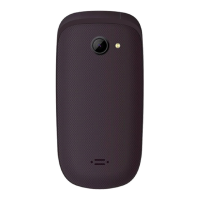
Do you have a question about the Maxcom MM818 and is the answer not in the manual?
| Display type | TFT |
|---|---|
| Pixel density | 167 ppi |
| Display diagonal | 2.4 \ |
| Display resolution | 240 x 320 pixels |
| Flash card support | Yes |
| Compatible memory cards | MicroSD (TransFlash) |
| Maximum memory card size | 32 GB |
| Rear camera resolution (numeric) | 0.3 MP |
| Wi-Fi | - |
| Data network | GSM |
| SIM card capability | Dual SIM |
| 2G bands (primary SIM) | 900, 1800 MHz |
| Mobile network generation | 2G |
| USB connector type | USB Type-C |
| Headphone connectivity | 3.5 mm |
| Multimedia Messaging Service (MMS) | Multimedia Messaging Service (MMS) is a standard way to send messages that include multimedia content to and from a mobile phone over a cellular network |
| Talk time (2G) | 5 h |
| Battery capacity | 750 mAh |
| Standby time (2G) | 300 h |
| Subscription type | No subscription |
| Product color | Black |
| Form factor | Clamshell |
| Phonebook capacity | 150 entries |
| Personal info management (PIM) | SOS |
| Depth | 20 mm |
|---|---|
| Width | 48 mm |
| Height | 93 mm |
| Weight | 78 g |
Guides on how to insert a SIM card into the phone for operation.
Details about the Personal Identification Number (PIN) for SIM card access.
Information on the phone's lock code to protect personal data.
Instructions on how to power the phone on and off.
Guide on how to dial numbers and initiate phone calls.
Setting up and managing emergency contacts for SOS functionality.
Entering personal and medical details for emergency use.
Customizing the text message sent during an emergency.
How to browse and view saved contacts in the phonebook.
Viewing received text and multimedia messages.
Settings for SMS center, priority, delivery reports, and voicemail.
Settings for MMS data accounts and common options.
Detailed view of received, missed, and dialed calls.
Configuring various call-related options.
Call settings specific to SIM card 1 and SIM card 2.
Viewing images stored on the memory card.
Using the phone's built-in video camera to record videos.
Playing video files stored on the memory card.
Using the phone's calendar to track dates and events.
Setting and managing alarms on the phone.
Managing sound profiles (General, Silent, Meeting, Outdoors).
Setting the phone's date, time, and format.
Configuring automatic phone power on and off times.
Changing the phone's menu and display language.
PIN lock and changing PIN/PIN2 codes for SIM cards.
Enabling, disabling, and managing Bluetooth connections.
Selecting a SIM card for data transfer.
Adding data accounts for WAP connection.
Using the phone's browser for WAP services.